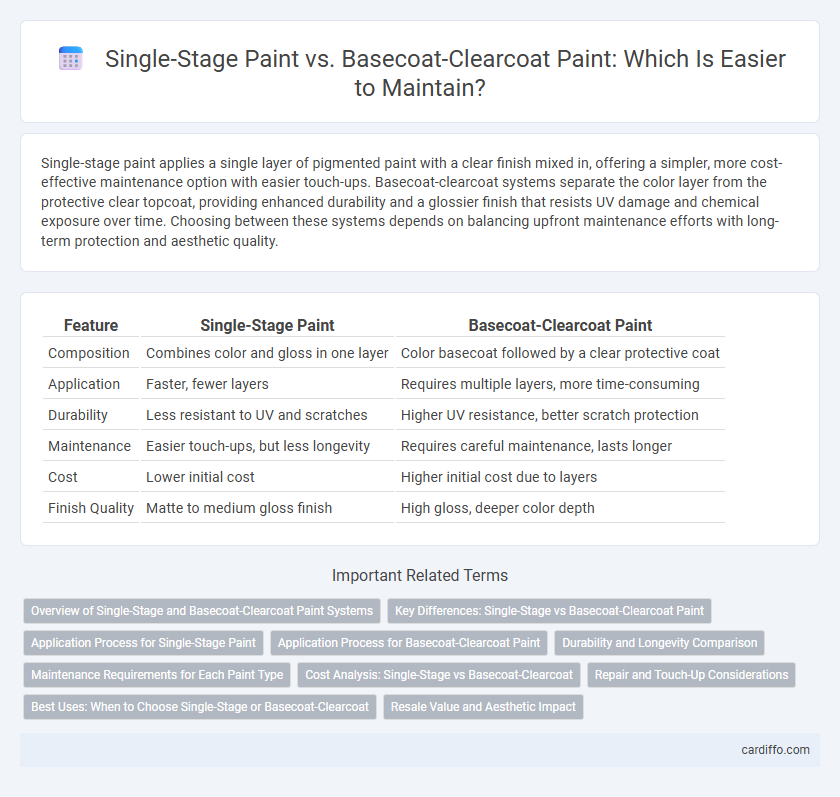Single-stage paint applies a single layer of pigmented paint with a clear finish mixed in, offering a simpler, more cost-effective maintenance option with easier touch-ups. Basecoat-clearcoat systems separate the color layer from the protective clear topcoat, providing enhanced durability and a glossier finish that resists UV damage and chemical exposure over time. Choosing between these systems depends on balancing upfront maintenance efforts with long-term protection and aesthetic quality.
Table of Comparison
| Feature | Single-Stage Paint | Basecoat-Clearcoat Paint |
|---|---|---|
| Composition | Combines color and gloss in one layer | Color basecoat followed by a clear protective coat |
| Application | Faster, fewer layers | Requires multiple layers, more time-consuming |
| Durability | Less resistant to UV and scratches | Higher UV resistance, better scratch protection |
| Maintenance | Easier touch-ups, but less longevity | Requires careful maintenance, lasts longer |
| Cost | Lower initial cost | Higher initial cost due to layers |
| Finish Quality | Matte to medium gloss finish | High gloss, deeper color depth |
Overview of Single-Stage and Basecoat-Clearcoat Paint Systems
Single-stage paint systems combine color and gloss in one layer, offering easier and faster application with fewer steps, commonly used for cost-effective repairs and older vehicles. Basecoat-clearcoat paint systems consist of a color basecoat followed by a clear protective topcoat, providing enhanced durability, UV resistance, and a deeper, glossier finish favored in modern automotive refinishing. Choosing between these systems depends on factors like application complexity, longevity requirements, and desired aesthetic quality.
Key Differences: Single-Stage vs Basecoat-Clearcoat Paint
Single-stage paint combines color and clear coat in one layer, offering a simpler application process but less durability and gloss compared to basecoat-clearcoat systems. Basecoat-clearcoat paint features separate layers for color and a protective clear coat, resulting in enhanced depth, UV resistance, and scratch protection. Maintenance is easier with basecoat-clearcoat due to its superior chemical and environmental resistance, requiring less frequent repainting or touch-ups.
Application Process for Single-Stage Paint
Single-stage paint simplifies the application process by combining color and clearcoat into one layer, reducing the number of steps required during repainting. This technique enables quicker drying times and minimizes the risk of clearcoat imperfections, making it ideal for maintenance and touch-ups. Technicians often prefer single-stage paint for its efficiency and reduced labor costs compared to basecoat-clearcoat systems.
Application Process for Basecoat-Clearcoat Paint
The Basecoat-Clearcoat paint application process involves two distinct layers: a pigmented basecoat that provides color and a transparent clearcoat that offers protection and shine. This method requires precise environmental controls, such as temperature and humidity regulation, to ensure proper adhesion and curing. Application typically demands specialized equipment and skilled technicians to achieve a smooth, durable finish that resists UV damage and oxidation.
Durability and Longevity Comparison
Single-stage paint typically offers quicker application but tends to be less durable and more prone to fading and chipping compared to basecoat-clearcoat systems. Basecoat-clearcoat paint provides superior UV protection and chemical resistance, significantly extending the vehicle's exterior lifespan. The dual-layer structure of basecoat-clearcoat ensures better adhesion and enhanced scratch resistance, promoting long-term aesthetic maintenance.
Maintenance Requirements for Each Paint Type
Single-stage paint requires simpler maintenance, as its uniform color and finish allow easier touch-ups and polishing without the need for specialized products. Basecoat-clearcoat paint demands more careful upkeep; the clear coat protects the base color but can be more susceptible to scratches and UV damage, necessitating regular waxing and proper cleaning techniques to maintain its appearance. For long-term durability, basecoat-clearcoat finishes benefit from periodic inspections and professional detailing to preserve the layers and prevent fading.
Cost Analysis: Single-Stage vs Basecoat-Clearcoat
Single-stage paint systems generally offer lower initial costs due to fewer application steps and reduced labor time, making them cost-effective for small repairs or repainting projects. Basecoat-clearcoat finishes involve higher expenses linked to the dual-layer application process, specialized materials, and increased labor intensity, but they provide superior durability and resistance to environmental damage. Over time, the enhanced longevity and ease of maintenance of basecoat-clearcoat paints can result in lower overall lifecycle costs despite the higher upfront investment.
Repair and Touch-Up Considerations
Single-stage paint simplifies repair and touch-up processes by requiring only one product, making it easier to match and apply without the need for separate layers. Basecoat-clearcoat systems offer superior durability and a high-gloss finish but demand precise application of both the base color and clear protective layers for effective repairs. Understanding the differences in layering and curing times is crucial for maintaining consistent color and finish quality during touch-ups.
Best Uses: When to Choose Single-Stage or Basecoat-Clearcoat
Single-stage paint is ideal for cost-effective repairs and vintage car restorations where simplicity and durability are prioritized, as it combines color and clear coat in one layer. Basecoat-clearcoat systems are best for modern vehicles requiring high gloss, UV protection, and enhanced depth, making them suitable for high-end finishes and complex color matching. Choosing between the two depends on project budget, desired finish quality, and environmental exposure conditions.
Resale Value and Aesthetic Impact
Single-stage paint offers a uniform finish that simplifies touch-ups and can preserve resale value by maintaining a consistent appearance over time. Basecoat-clearcoat paint provides a deeper gloss and enhanced color depth, significantly boosting aesthetic appeal and potentially increasing a vehicle's resale value through superior finish durability. Professional maintenance of basecoat-clearcoat systems ensures long-lasting protection against fading and chipping, directly contributing to sustained market value.
Single-Stage Paint vs Basecoat-Clearcoat Paint Infographic

 cardiffo.com
cardiffo.com